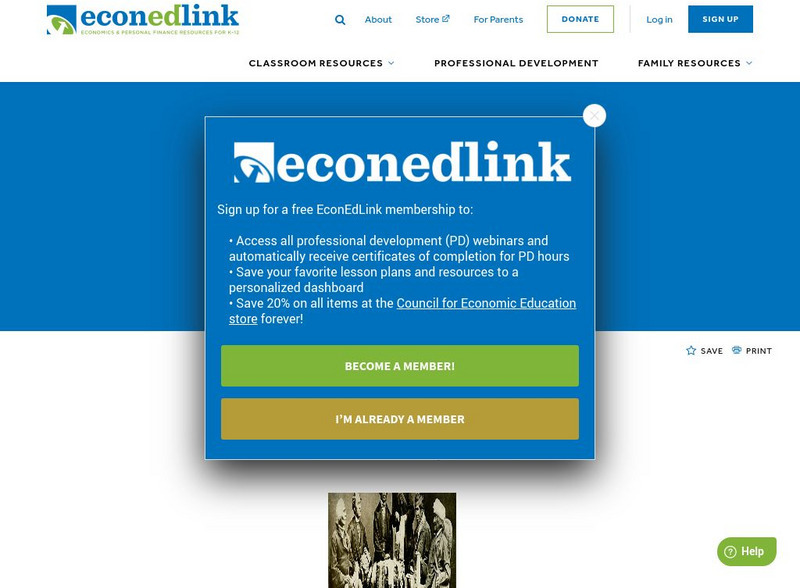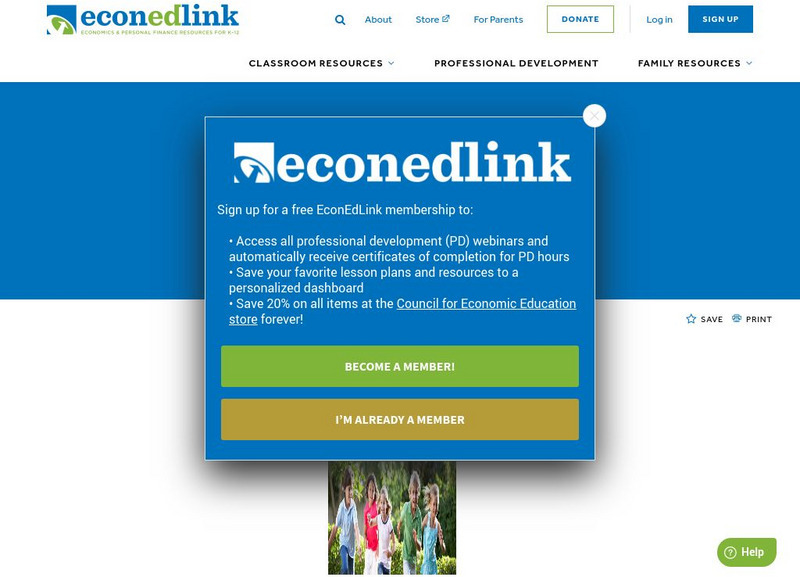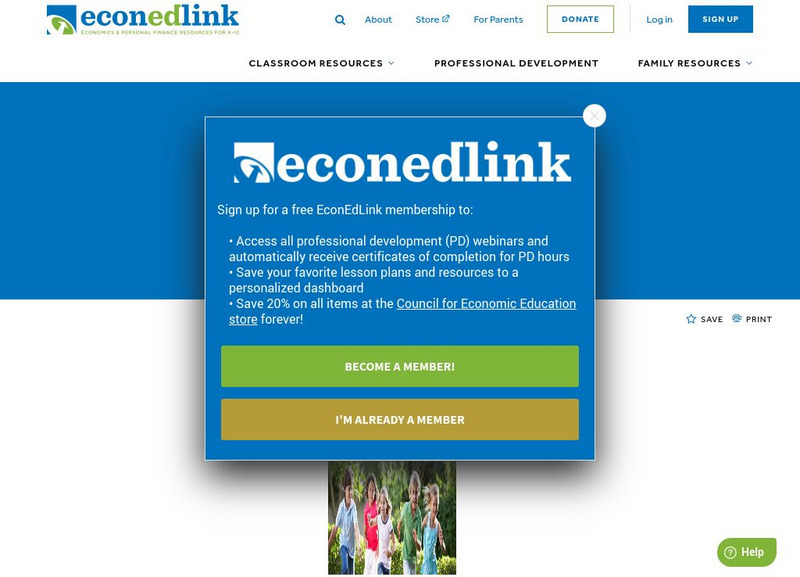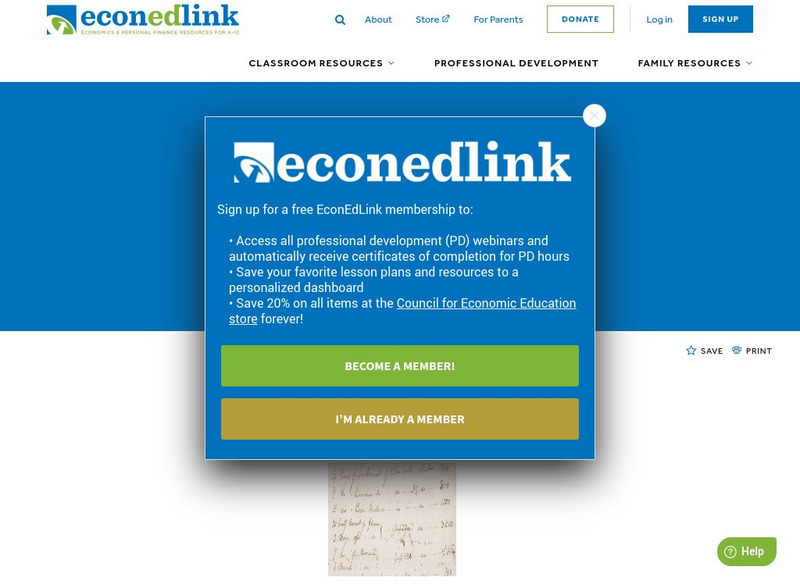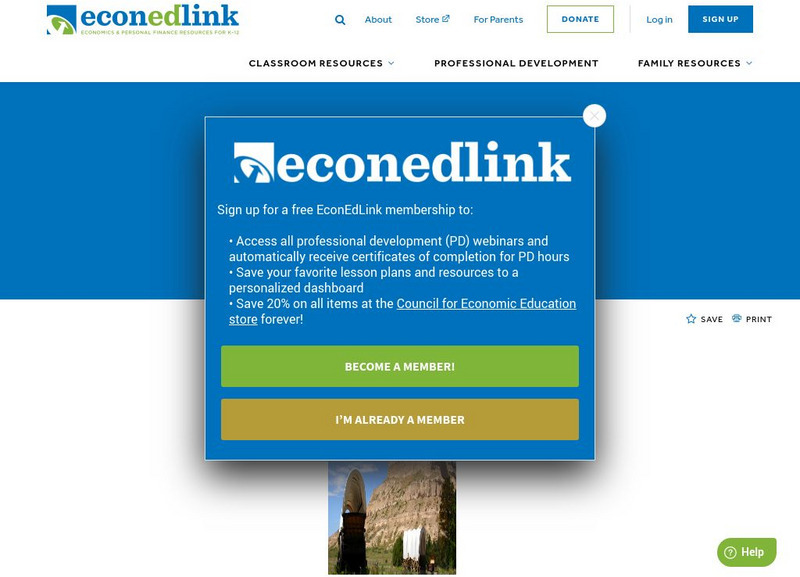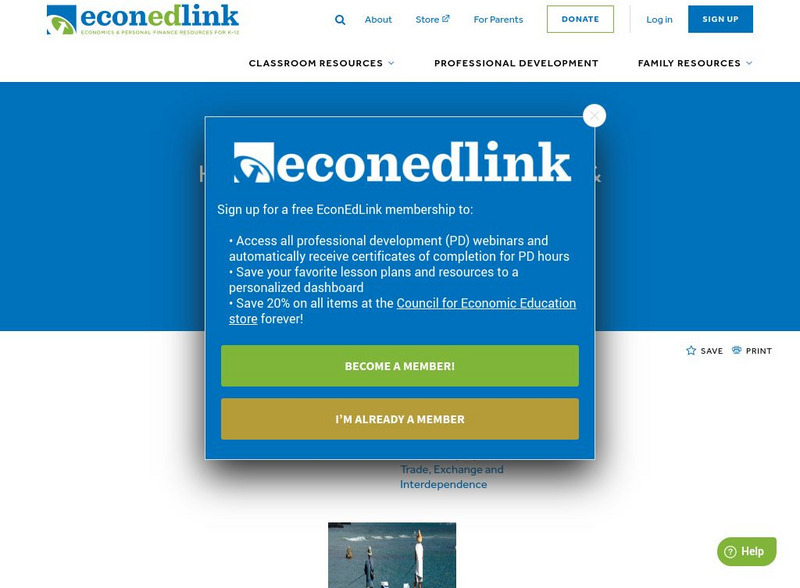Council for Economic Education
Econ Ed Link: I Have No Money, Would You Take Wampum?
Through the use of folk tales, history, and the students' own experiences, students will recognize the inter-relatedness of goods, services, money. They will locate information about barter as a means of trade, use folk tales as an...
Council for Economic Education
Econ Ed Link: I Have No Money, Would You Take a Wampum?
This site teaches students about traditional economies and how exchanges of goods and services were made before money. Students learn about a bater economy which predates our traditional economy.
Council for Economic Education
Econ Ed Link: Frontier Specialists
The level of output in an economy can be increased through specialization. Economic specialization occurs when people produce different goods and services than they consume. It requires people to exchange goods and services.
Council for Economic Education
Econ Ed Link: Fewer Watts and Fatter Wallets
Students learn about incentives for alternative energy programs and the role played by non-price determinants in energy choices.
Council for Economic Education
Econ Ed Link: Country Mouse Makes a Decision! (Student Version)
Use this site to teach your primary students how to identify the costs and benefits of making a decision. Animated link to the story, Country Mouse Makes a Decision, makes this an entertaining and educational economics lesson.
Council for Economic Education
Econ Ed Link: Costs and Benefits of 'The Three Little Pigs'
Find out what the definition of a cost and a benefit is in terms of the economy when using this site. "When making a decision, students should consider the costs and the benefits of that decision."
Council for Economic Education
Econ Ed Link: The Mystery of Is It Mine or Ours? (Educator Version)
Did you ride to school on a road today? Yesterday did you skate in a public park? Maybe Mom or Dad traveled home from one of your ball games on their bicycles under a string of street lights? How did the road, the park or the street...
Council for Economic Education
Econ Ed Link: The Mystery of Is It Mine or Ours?
Students will learn that people respond predictably to positive incentives (rewards) and negative incentives (penalties). They will identify incentives in their daily lives at home and school. Students will discuss which incentives have...
Council for Economic Education
Econ Ed Link: Scarcity With the Lewis & Clark Expedition (Student Version)
Use this EconEdLink intermediate lesson to teach your students about the concept of scarcity. Allow students to use the interactive simulation of the Lewis and Clark Expedition to demonstrate their ability to make sound decisions in the...
Council for Economic Education
Econ Ed Link: Scarcity With the Lewis and Clark Expedition (Teacher Version)
The Lewis and Clark expedition was filled with scarcity issues. They made life and death choices based on scarcity. In this lesson plan, you will travel back to the early 1800's in a time machine and travel with Lewis and Clark. See if...
Council for Economic Education
Econ Ed Link: China Where Will They Fit in the World Economy?
With its emerging middle class, its new markets, and a new emphasis on increasing its technology base, where is China going to fit in the world economy?
Council for Economic Education
Econ Ed Link: Chevy Volt It's Electric!
The costs and benefits of owning an electric or hybrid car will be evaluated in this lesson. By reading and researching the history of the production of electric cars, the lesson allows students to understand how this market has developed.
Council for Economic Education
Econ Ed Link: This Little Piggybank Went to Market
A good lesson that conveys to young students why people work and why they keep their money in banks.
Council for Economic Education
Econ Ed Link: Off to Interactive Island
This activity provides a fun way to explore concept of economic decision making. In the lesson, young scholars are given a limited number of "tokens" and asked to exchange those tokens for goods in preparation for pioneering in a new...
Council for Economic Education
Econ Ed Link: Off to Interactive Island
This site is a instructional activity that teaches students about scarcity and choice. Students participate in a simulation where they are asked to make choices about what they want to take with them in order to survive.
Council for Economic Education
Econ Ed Link: Nothing to Buy
This site is a printable lesson that compares the command economy of Soviet Russia with the market economy of present day Russia. Lesson provides tables with data comparing prices within the two systems. Discussion questions are also...
Council for Economic Education
Econ Ed Link: Hawaiian Economics: Barter for Fish & Poi
In ancient Hawaii, chiefs managed the economy by creating a land division system, the Ahupua'a, which divided the islands into pie slice shapes. Each Ahupua'a covered the three main regions of the islands: the mountains, the valleys, and...
Council for Economic Education
Econ Ed Link: Hawaiian Economics: Barter for Fish & Poi
Use this lesson to learn more about the Hawaiian economics system. Learn how they developed and used this specialized type of money system. "For this lesson, you will learn how specialization and division of labor increased productivity...
Council for Economic Education
Econ Ed Link: Dynamic Decision Making
Students will be introduced to the PACED Model and learn to use the parts of the model-- Problem, Alternatives, Criteria, and Evaluation- in solving problems and making decisions. They will practice using the model in decisions about...
Council for Economic Education
Econ Ed Link: Demand Shifters
Check out this informative economics lesson plan that teaches about demand, and factors that cause demand for a good or service to change. Middle schoolers learn to recognize factors that influence one's behavior as a consumer.
Council for Economic Education
Econ Ed Link: A Penny Saved Is a Penny at 4.7% Earned
There are lots of ways to receive income, and lots of ways to spend it. In this EconomicsMinute you will develop two budgets to help you decide how to allocate your income. Assuming you do not love making dollar bill rings.
Council for Economic Education
Econ Ed Link: A Penny Saved Is a Penny at 4.7% Earned
This is a lesson from EconEdLink where students learn about saving money. Includes activities and materials.
Council for Economic Education
Econ Ed Link: Climbing the Savings Mountain
Students discover how saving money can be compared to a mountain climb. The climb can be fast or slow, safe or hazardous, scenic or thrilling. You will find out that there is more than one way to get to the top!
Council for Economic Education
Econ Ed Link: Climbing the Savings Mountain
Check out this lesson plan to learn how to develop a savings plan that is right for you.



